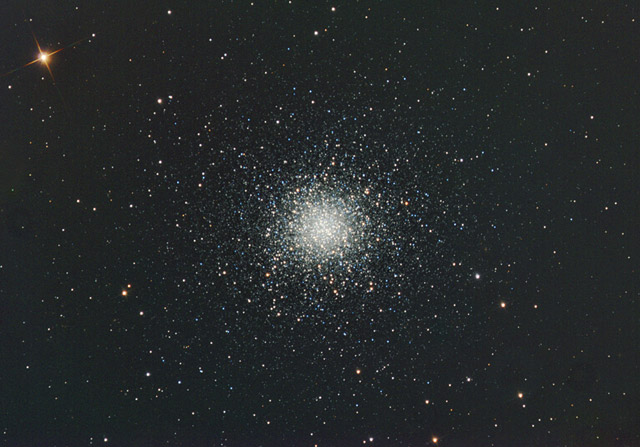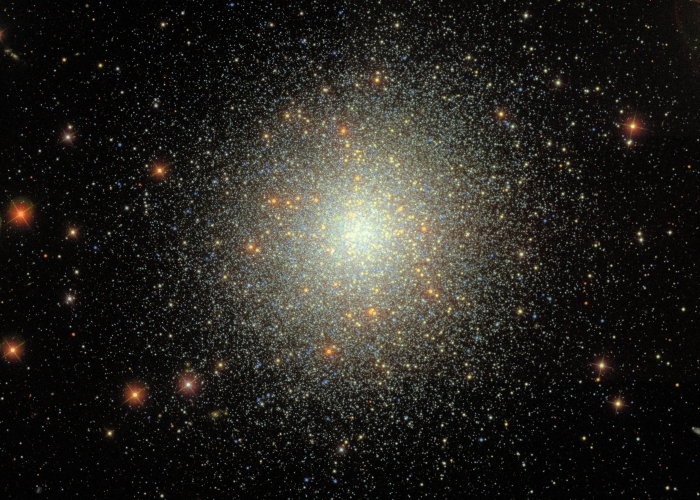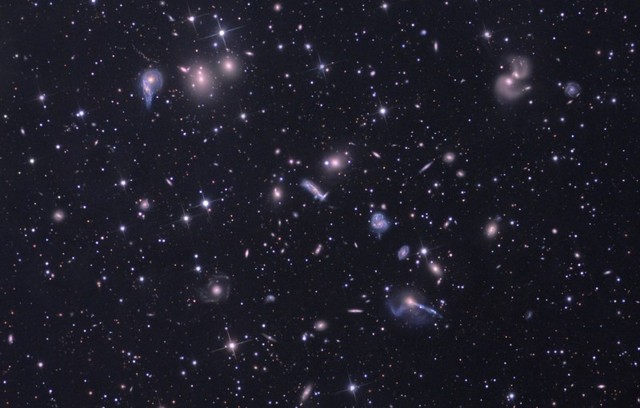| Time Travel Research Center © 2005 Cetin BAL - GSM:+90 05366063183 - Turkey/Denizli | |||
|
|
|||
|
M13
|
||
|
HERCULES - GLOBULAR CLUSTER - MAG 5.8 |
|||

M13 - THE GREAT HERCULES CLUSTER
|
About this Object: |
|
Known by most as the most spectacular globular cluster in the northern sky, the Great Hercules Cluster can often be seen with the naked eye in dark skies.. As globular clusters go, this cluster, also known as Messier 13, is quite large in size from our perspective, approximately 20 arc minutes wide. The star at the upper-left of this image is a 6.86 magnitude K2 spectral star. M13 is very easy to find in the night sky, making it one of the first deep sky objects found by beginning hobbyists. Just look to the western side of the Hercules "keystone" and search along that line about 1/3 the way from the northern-most star on that side. Any scope can detect the object, but the individual stars in the cluster need 6 to 8 inches of aperture to really appreciate. |
Location:
Comanche Springs, 3RF
dark sky site near Crowell, Texas
Date: May 19, 2005
Seeing:
5/10
Transparency: 8/10 (mag. 3.5 skies, 11 day moon)
Temperature: 62 degrees F (-15 degrees C on camera)
Scope/Mount: 12.5" RCOS RC @ f/9 and Paramount ME
Camera: SBIG STL-11000M astro CCD camera
Exposure Info: LRGB image; 45:30:45 RGB with synthetic
luminance (5 minute subexposures all unbinned)
Processing
Information:
Calibration (darks/flats),
Registration, gradient removal, DDP, and RGB channel combine in MaxIm DL 4 (Sigma
median). LRGB combine, cropping, color balance, levels/curves, sharpening,
and noise removal (despeckle and gaussian blur) in Photoshop CS.
Exposure Notes: I normally don't image with the moon so bright, but bad weather made me desperate! Still, such an object doesn't require very dark skies, and the magic of image processing really helps to even the background caused by the bright moon. It should be noted that the RC still isn't optimally collimated and aligned yet.

Shown is one of the more prominent globular clusters in the Northern night sky, Messier 13, in Hercules. This cluster is one of the brightest clusters, and is often one of the first stops for a beginning observer. Visible in the summer sky, this cluster is about 6 visual magnitudes, and will be barely visible with the naked eye from dark skies. M13 was also one of the first targets for potential contact with other civilizations, as it was beamed a radio message from the Arecibo Observatory in 1974.

Herkül Gökada Kümesi
Açıklama : Burada gördüğünüz gökadalar, bizden yalnızca 500 milyon ışıkyılı
uzaklıkta yer alan bir "ada evrenler" takımadası olan Herkül Kümesi'ne ait
gökadalardır. Abell 2151 olarak da bilinen bu küme, gaz ve toz bakımından
zengin, yıldız oluşturan sarmal gökadalar ile doludur; ancak nispeten daha
az sayıda eliptik gökada içermektedir ki, bunlar da gaz ve toz ile yeni
doğmuş yıldız bakımlarından oldukça zayıftır. Dikkat çekici bir derinliğe
sahip olan bu birleşik resimdeki renkler, yıldız oluşturan gökadaları mavi
tonlarda, daha yaşlı bir yıldız nüfusuna sahip gökadaları ise sarımsı
tonlarda açık bir biçimde göstermektedir. Bu net görüntü, kümenin merkezi
boyunca yaklaşık 1/2 derece gelmektedir ve bu da kümenin tahmini uzaklığında
4 milyon ışıkyılının üzerinde bir uzaklığa denk gelmektedir. Bu uzay
manzarası içerisinde birçok gökada çarpışıp, birleşirken, bazıları biçim
bozukluğuna uğramış gibi görünmektedir. Bu durum, küme gökadalarının
halihazırda birbirleriyle etkileşim halinde olduklarının açık bir kanıtıdır.
Aslına bakarsanız, Herkül Kümesi'nin kendisi, daha küçük gökada kümelerinin
devam etmekte olan birleşmelerinin bir sonucu olarak görülebilir ve bu
kümenin, evrenin başlangıcında, çok daha uzaklarda yer alan genç gökada
kümelerine benzediği düşünülmektedir.
Astronomi Galaxy Resimler Nebula Resimler Yıldız Kümeleri Resimleri Astrophotography
Copyright(c) 2003 - 2005 Cetinbal All rights reserved.